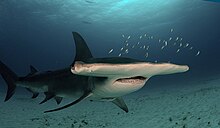| Great hammerhead Temporal range:
| |
|---|---|

| |
| Scientific classification | |
| Domain: | Eukaryota |
| Kingdom: | Animalia |
| Phylum: | Chordata |
| Class: | Chondrichthyes |
| Subclass: | Elasmobranchii |
| Order: | Carcharhiniformes |
| Family: | Sphyrnidae |
| Genus: | Sphyrna |
| Species: | S. mokarran
|
| Binomial name | |
| Sphyrna mokarran (Rüppell, 1837)
| |

| |
| Range of the great hammerhead | |
| Synonyms | |
| |
The great hammerhead (Sphyrna mokarran) is the largest species of hammerhead shark, belonging to the family Sphyrnidae, attaining an average length of 4.6 m (15 ft) and reaching a maximum length of 6.2 m (20 ft). It is found in tropical and warm temperate waters worldwide, inhabiting coastal areas and the continental shelf. The great hammerhead can be distinguished from other hammerheads by the shape of its "hammer" (called the "cephalofoil"), which is wide with an almost straight front margin, and by its tall, sickle-shaped first dorsal fin. A solitary, strong-swimming apex predator, the great hammerhead feeds on a wide variety of prey ranging from crustaceans and cephalopods, to bony fish, to smaller sharks. Observations of this species in the wild suggest that the cephalofoil functions to immobilize stingrays, a favored prey. This species has a viviparous mode of reproduction, bearing litters of up to 50 pups every two years.
Although potentially dangerous, the great hammerhead rarely attacks humans and can sometimes behave inquisitively toward divers. This shark is heavily fished for its large fins,[4][5] which are valuable on the Chinese market as the main ingredient of shark fin soup.[6] As a result, great hammerhead populations are declining substantially worldwide, and it has been assessed as critically endangered by the International Union for Conservation of Nature (IUCN) as of 2019.[2]
- ^ MacPhee, Ross; Iturralde-Vincent, Manuel A.; Gaffney, Eugene S. (19 February 2003). "Domo de Zaza, an Early Miocene Vertebrate Locality in South-Central Cuba, with Notes on the Tectonic Evolution of Puerto Rico and the Mona Passage". American Museum Novitates. 2003 (3394): 1–42. doi:10.1206/0003-0082(2003)394<0001:DDZAEM>2.0.CO;2. Retrieved 10 October 2024.
- ^ a b Rigby, C.L.; Barreto, R.; Carlson, J.; Fernando, D.; Fordham, S.; Francis, M.P.; Herman, K.; Jabado, R.W.; Liu, K.M.; Marshall, A.; Pacoureau, N.; Romanov, E.; Sherley, R.B.; Winker, H. (2019). "Sphyrna mokarran". IUCN Red List of Threatened Species. 2019: e.T39386A2920499. doi:10.2305/IUCN.UK.2019-3.RLTS.T39386A2920499.en. Retrieved 19 November 2021.
- ^ "Appendices | CITES". cites.org. Retrieved 2022-01-14.
- ^ Ebert, David A.; Dando, Marc; Fowler, Sarah (20 July 2021). Sharks of the World: A Complete Guide. Princeton University Press. p. 569. ISBN 978-0-691-20599-1. Retrieved 22 September 2023.
- ^ Márquez, Melissa Cristina. "U.S. Government Decides Against Adding Great Hammerhead Shark To Endangered Species List". Forbes. Retrieved 22 September 2023.
- ^ Federal Register. Office of the Federal Register, National Archives and Records Service, General Services Administration. April 2013. p. 24703. Retrieved 22 September 2023.
